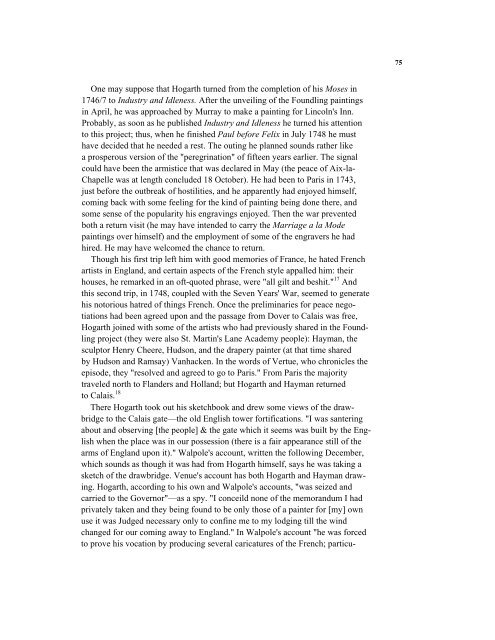You also want an ePaper? Increase the reach of your titles
YUMPU automatically turns print PDFs into web optimized ePapers that Google loves.
One may suppose that <strong>Hogarth</strong> turned from the completion of his Moses in<br />
1746/7 to Industry <strong>and</strong> Idleness. After the unveiling of the Foundling paintings<br />
in April, he was approached by Murray to make a painting for Lincoln's Inn.<br />
Probably, as soon as he published Industry <strong>and</strong> Idleness he turned his attention<br />
to this project; thus, when he finished Paul before Felix in July 1748 he must<br />
have decided that he needed a rest. The outing he planned sounds rather like<br />
a prosperous version of the "peregrination" of fifteen years earlier. The signal<br />
could have been the armistice that was declared in May (the peace of Aix-la-<br />
Chapelle was at length concluded 18 October). He had been to Paris in 1743,<br />
just before the outbreak of hostilities, <strong>and</strong> he apparently had enjoyed himself,<br />
coming back with some feeling for the kind of painting being done there, <strong>and</strong><br />
some sense of the popularity his engravings enjoyed. Then the war prevented<br />
both a return visit (he may have intended to carry the Marriage a la Mode<br />
paintings over himself) <strong>and</strong> the employment of some of the engravers he had<br />
hired. He may have welcomed the chance to return.<br />
Though his first trip left him with good memories of France, he hated French<br />
artists in Engl<strong>and</strong>, <strong>and</strong> certain aspects of the French style appalled him: their<br />
houses, he remarked in an oft-quoted phrase, were "all gilt <strong>and</strong> beshit." 17 And<br />
this second trip, in 1748, coupled with the Seven Years' War, seemed to generate<br />
his notorious hatred of things French. Once the preliminaries for peace nego-<br />
tiations had been agreed upon <strong>and</strong> the passage from Dover to Calais was free,<br />
<strong>Hogarth</strong> joined with some of the artists who had previously shared in the Found-<br />
ling project (they were also St. Martin's Lane Academy people): Hayman, the<br />
sculptor Henry Cheere, Hudson, <strong>and</strong> the drapery painter (at that time shared<br />
by Hudson <strong>and</strong> Ramsay) Vanhacken. In the words of Vertue, who chronicles the<br />
episode, they "resolved <strong>and</strong> agreed to go to Paris." From Paris the majority<br />
traveled north to Fl<strong>and</strong>ers <strong>and</strong> Holl<strong>and</strong>; but <strong>Hogarth</strong> <strong>and</strong> Hayman returned<br />
to Calais. 18<br />
There <strong>Hogarth</strong> took out his sketchbook <strong>and</strong> drew some views of the draw-<br />
bridge to the Calais gate—the old English tower fortifications. "I was santering<br />
about <strong>and</strong> observing [the people] & the gate which it seems was built by the Eng-<br />
lish when the place was in our possession (there is a fair appearance still of the<br />
arms of Engl<strong>and</strong> upon it)." Walpole's account, written the following December,<br />
which sounds as though it was had from <strong>Hogarth</strong> himself, says he was taking a<br />
sketch of the drawbridge. Venue's account has both <strong>Hogarth</strong> <strong>and</strong> Hayman draw-<br />
ing. <strong>Hogarth</strong>, according to his own <strong>and</strong> Walpole's accounts, "was seized <strong>and</strong><br />
carried to the Governor"—as a spy. "I conceild none of the memor<strong>and</strong>um I had<br />
privately taken <strong>and</strong> they being found to be only those of a painter for [my] own<br />
use it was Judged necessary only to confine me to my lodging till the wind<br />
changed for our coming away to Engl<strong>and</strong>." In Walpole's account "he was forced<br />
to prove his vocation by producing several caricatures of the French; particu-<br />
75
















